As an Amazon Associate CoffeeXplore.com earns from qualifying purchases.
Cold Brew Coffee Master Guide To Smooth Low Acid Ratio Secrets
Tired of that harsh, bitter bite in your morning coffee? You know there’s a smoother, richer way to get your caffeine fix, but your homemade attempts just don’t measure up.
Cold brew coffee is a preparation method using cold water over many hours, specifically designed to eliminate that acidic bitterness. But achieving that perfect, cafe-quality consistency at home can feel like a frustrating guessing game.
Cold brew coffee: a smooth, low-acid concentrate made by steeping coarse grounds in cold water for 12-24 hours, which can reduce bitterness by up to 67%. This guide unlocks the 11 essential secrets to mastering the perfect ratio and process, ensuring you get professional results every single time.
Tired of Bitter Coffee? Unlocking the Smooth, Low-Acid Secret of Cold Brew
You’re not imagining it. That sharp, often sour taste in hot-brewed coffee is a real chemical reaction. The secret to the incredibly smooth, rich flavor of cold brew coffee lies in its unique preparation method: cold water extraction. This process avoids high temperatures, which are responsible for pulling out bitter-tasting chlorogenic acids from the coffee grounds.
This ultimate cold brew guide moves beyond simple recipes. We’ll explore the science behind why it works and give you a tested, actionable methodology to solve inconsistency forever. By mastering a few key variables, like the precise cold brew ratio, you can create a high-caffeine, low-acid coffee concentrate that puts expensive coffee shop drinks to shame. Our methods are based on real-world testing to guarantee a smooth coffee experience.
The Science Behind the Smoothness: Why Cold Water Extraction Matters
The defining characteristic of cold brew coffee is its gentle, heat-free brewing process, which significantly limits the extraction of bitter chlorogenic acids, resulting in a beverage that is up to 67% less acidic than its hot-brewed counterpart. By steeping coarse coffee grounds in cold or room-temperature water for 12 to 24 hours, you fundamentally change the extraction kinetics.
Hot water is an aggressive solvent. It rapidly dissolves flavor compounds but also extracts unwanted elements that cause bitterness and high acidity. It also triggers the Maillard reaction, creating certain flavor profiles not present in cold brew. Cold water, on the other hand, is a much slower, more selective solvent. It takes many hours to gently pull out the desirable sweet, chocolatey, and nutty flavor compounds while leaving most of the bitter acids behind.
According to professional standards from organizations like the Specialty Coffee Association (SCA), a successful extraction yield for coffee falls between 16% and 20%. Cold brew achieves this target range through time rather than temperature. The result is a coffee with a smoother, more balanced profile and a naturally higher pH level, making it easier on your stomach and palate.
11 Essential Secrets to Mastering the Perfect Low-Acid Cold Brew Ratio at Home
Making consistently great homemade cold brew isn’t about luck; it’s about precision. These 11 essential secrets are the definitive guide for 2025, combining tested methods and expert insights to help you produce a perfect, sediment-free concentrate every time. Follow these step-by-step instructions to unlock the full potential of your coffee beans.
1. Mastering the Core 1:8 Coffee-to-Water Ratio

Pin this genius hack to your ‘Cold Brew Essentials’ board!
The single most important variable for consistent cold brew is the brewing ratio. For a versatile, high-concentration coffee concentrate, the industry standard is a 1:8 ratio—that means 1 part coffee to 8 parts water by weight. Measuring by weight, not volume, eliminates inconsistencies from different bean densities and grind sizes.
Materials Needed:
- Digital Kitchen Scale (must measure to 0.1g accuracy)
- Filtered Water (cold or room temperature)
- Coarse Coffee Grounds (freshly ground, specific weight calculated)
Step-by-Step Directions:
- Determine Target Volume: Decide how much water you’ll use. For example, 64 ounces of water is approximately 1800 grams (g).
- Calculate Grounds: Divide your water weight by 8 to find the required coffee weight. For 1800g of water, you need 225g of coffee grounds (1800 ÷ 8 = 225).
- Measure Precisely: Use the digital scale to measure your coffee and water by weight in grams for perfect accuracy.
- Mix & Saturate: Combine the measured water and grounds in your brewing vessel. Stir gently for about 30 seconds until all grounds are fully saturated, creating what is known as a ‘slurry’.
Pro-Tip: Always start with the 1:8 ratio. If the resulting concentrate is too strong for your taste after dilution, you can dilute it further. If it’s too weak, adjust to a stronger 1:7 or 1:6 ratio for your next batch.
2. Using a Coarse, Uniform Grind for Sediment-Free Extraction
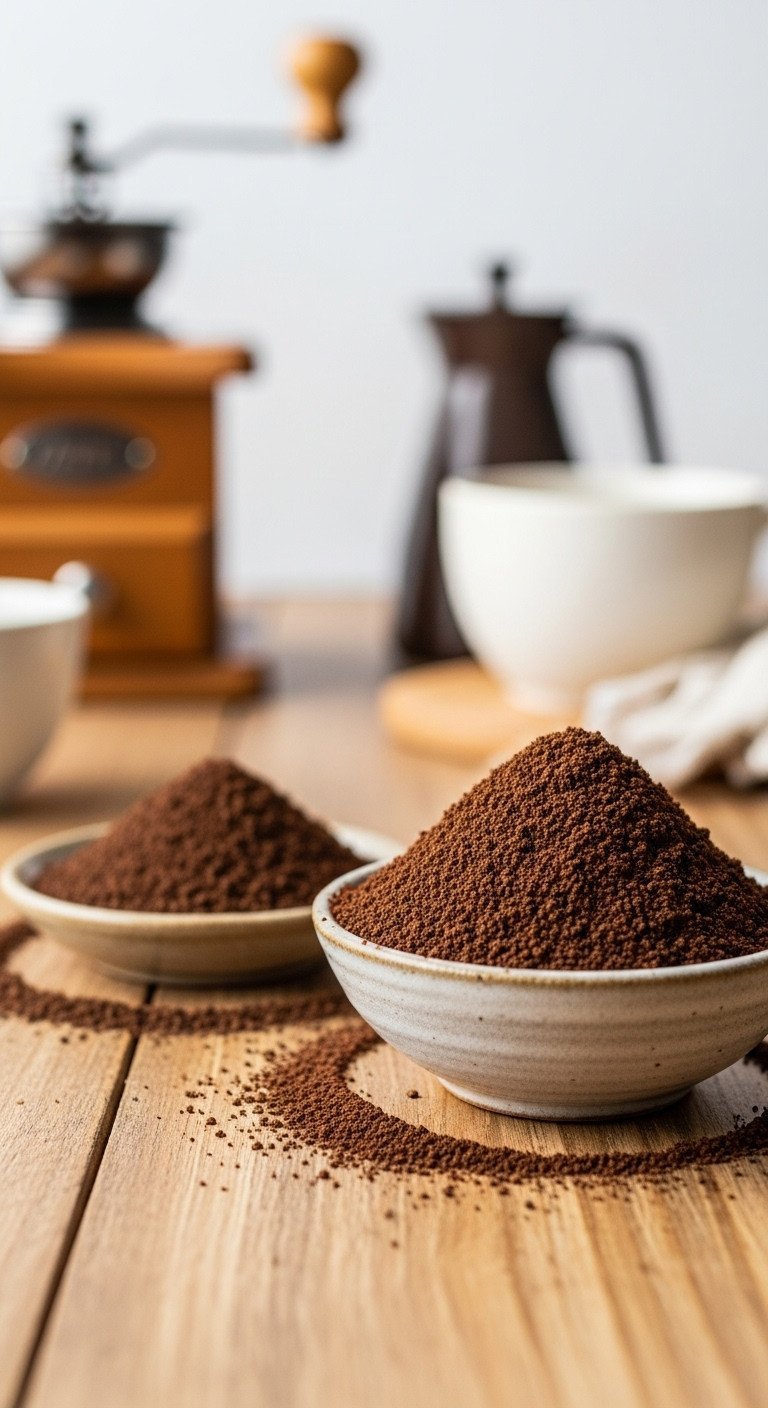
Save this clever organization idea!
Grind consistency is the secret weapon against bitterness. A coarse, uniform grind is essential because it allows water to extract flavor evenly over the long steeping time. Fine particles, or “fines,” extract much faster, leading to over-extraction, bitterness, and a gritty, cloudy concentrate.
Tools Needed:
- High-Quality Burr Grinder (mandatory for uniform size)
- Fresh, Whole Coffee Beans
Step-by-Step Directions:
- Avoid Blade Grinders: Blade grinders shatter beans into inconsistent particles, creating excessive fines. A burr grinder is a non-negotiable investment for quality cold brew.
- Set Coarse Grind: Adjust your burr grinder to its coarsest setting. The grounds should resemble coarse sea salt, crushed peppercorns, or rough breadcrumbs.
- Grind Just Before Use: To preserve the volatile aromatic compounds, grind only the amount of coffee you need right before you mix it with water.
- Inspect Consistency: Check a small handful of grounds. If you see a lot of fine powder, your grind setting is too fine or your grinder may need adjustment.
Pro-Tip: Fines can extract up to 100 times faster than coarse grounds, introducing bitterness even in cold water. A uniform coarse grind is your best defense against both over-extraction and unwanted sediment.
3. Hitting the 18-Hour Sweet Spot for Maximum Flavor Extraction

Set a reminder to save this ultimate steep time secret!
While ratios and grind are foundational, steeping time is where flavor is truly developed. The optimal steep time extracts the maximum amount of desirable flavor compounds without pulling out the bitter notes that come from over-extraction. For most coarse grinds, this sweet spot is between 16 and 20 hours.
Requirements:
- Measured Slurry (coffee grounds and water mixture)
- Airtight Steeping Vessel (mason jar, pitcher, or brewer)
- Refrigerator or Cool, Dark Place
Step-by-Step Directions:
- Mix and Seal: After mixing your grounds and water, immediately cover the vessel tightly. This prevents oxidation and stops the coffee from absorbing any unwanted odors from the refrigerator.
- Start Timer: Set a timer for 18 to 20 hours if steeping in the refrigerator. If you must steep at room temperature, reduce this to 16 hours.
- Avoid Agitation: Once sealed, do not stir, shake, or otherwise agitate the slurry. This can disturb the bed of grounds and push fine particles into the liquid, making filtration more difficult.
- Test Taste: At the 18-hour mark, strain a very small sample, dilute it 1:1 with water, and taste it. If it’s robust and smooth, it’s ready for filtration. If it tastes weak or thin, let it steep for another 2 hours and test again.
Pro-Tip: The relationship between grind size and steep time is critical. If you are forced to use a medium-coarse grind, you must reduce your steep time to around 12-15 hours to avoid bitterness. The coarser the grind, the longer the required steep.
4. Selecting the Optimal Roast Level: Dark Roast vs. Medium Roast
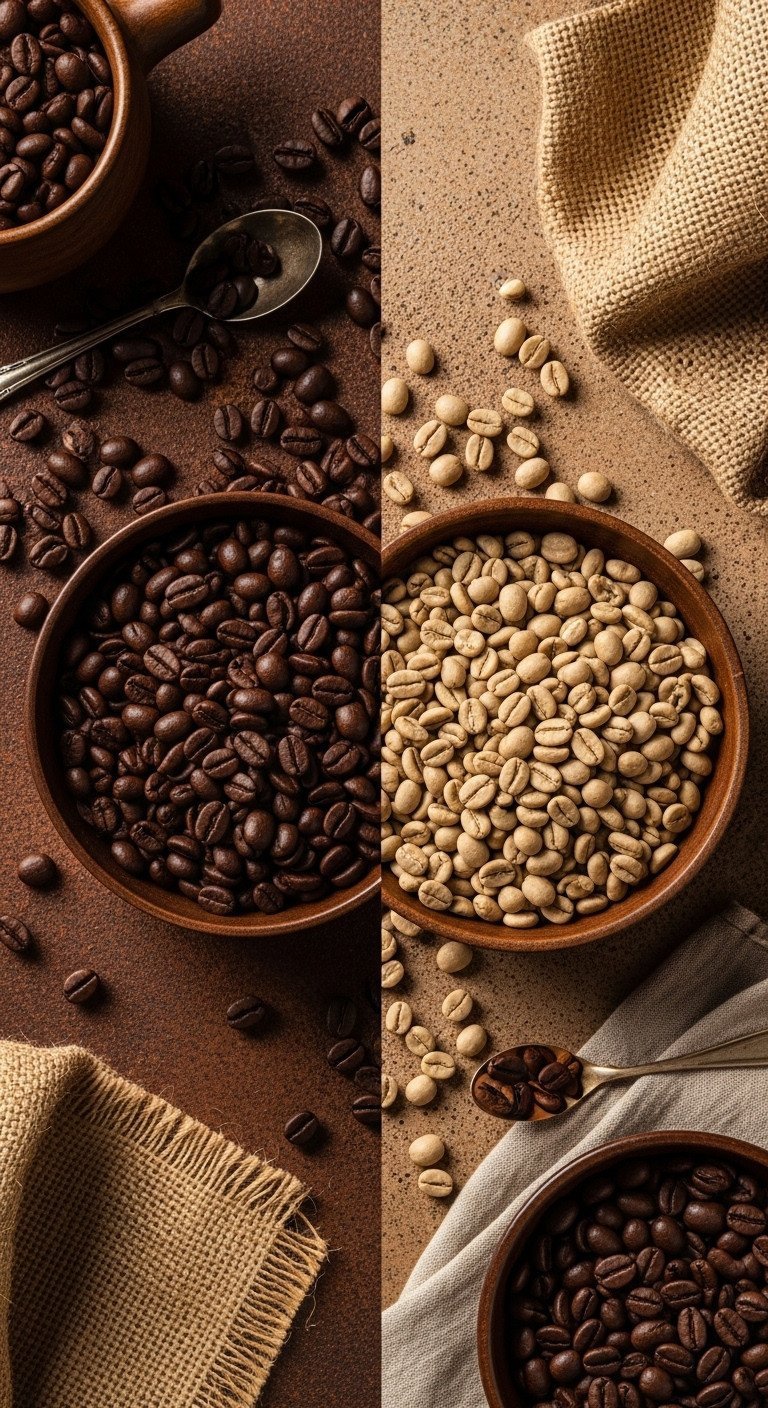
Pin this flavor selection secret for your next batch!
The roast level of your coffee beans will have a huge impact on the final flavor profile of your cold brew. There’s no single “best” roast; the right choice depends entirely on your taste preference.
Criteria for Bean Selection:
- Quality, Freshly Roasted Whole Beans
- Specific Roast Level (Medium or Dark)
- Flavor Profile Goals (Bold/Chocolatey or Bright/Fruity)
Flavor Profile Decisions:
- Go Dark for Body: Choose a dark roast for a classic cold brew experience. This will yield a heavy body, very low acidity, and dominant notes of chocolate, nuts, and caramel. Dark roasts are also more forgiving of minor brewing errors.
- Go Medium for Complexity: Select a medium roast if you prefer more flavor clarity and complexity. These beans will produce a brew with more pronounced fruity, floral, or bright notes. However, they require precise grinding and steeping to avoid unwanted sourness.
- Avoid Flavored Beans: The cold brew process excels at drawing out the natural, nuanced flavors of the coffee itself. Using pure, unflavored beans will yield the best results.
- Check Roast Date: Always use beans that were roasted within the last four weeks. Freshness is key to a vibrant, flavorful brew.
Lesson Learned: Cold brew is famous for reducing acidity, but it doesn’t eliminate it. Using an inherently acidic light roast will still result in a more acidic final product than using a dark roast. Choose your roast level based on your desired final taste and pH.
5. The Double Filtration Technique for Crystal-Clear Concentrate
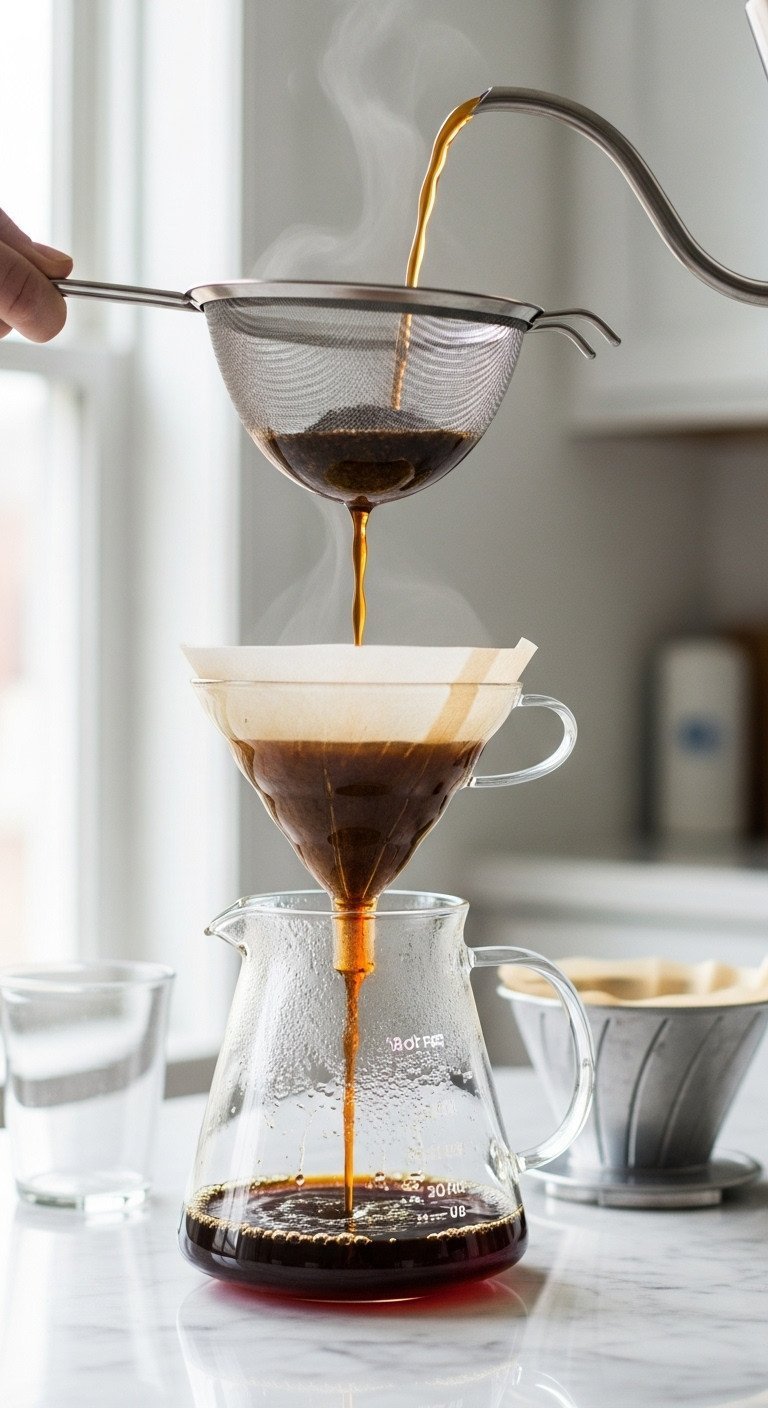
Save this clear coffee hack now!
A clean finish and smooth mouthfeel are hallmarks of great cold brew. The key to achieving this is a patient, two-stage double filtration process that removes both the large coffee grounds and the microscopic fine particles (sediment) that cause grittiness.
Supplies Needed:
- Fine Mesh Strainer (or a dedicated immersion brewer filter)
- Paper Filters (basket or cone type) or several layers of cheesecloth
- Clean Glass Carafe or Storage Jar
Step-by-Step Directions:
- First Pass (Coarse): Gently pour the entire coffee slurry through a fine mesh strainer into a large bowl or pitcher. This first pass will catch the bulk of the large, coarse grounds quickly.
- Second Pass (Fine): Line a second strainer or a funnel with a paper coffee filter. Slowly pour the liquid from the first pass through this paper filter into your final, clean storage container.
- Do Not Rush: This second stage is slow. Let gravity do all the work. Squeezing or pressing the filter will force fine sediment through, defeating the purpose of this step.
- Discard Sludge: Dispose of the spent grounds and the used filters. The result will be a crystal-clear concentrate with a clean finish.
Pro-Tip: If you’re using a French press as your brewing vessel, you can use its plunger as the first filtration step. Press the plunger down very slowly, then pour the liquid through a paper filter for the second, fine-filtering pass.
6. Why Filtered Water Quality is Non-Negotiable

Don’t overlook this crucial flavor secret!
Since your final drink is over 98% water, the quality of that water has a massive impact on flavor. Tap water often contains chlorine or high levels of minerals that can create off-tastes, which become concentrated and magnified during the long steeping process.
Requirements & Tools:
- High-Quality Water Filter Pitcher or Reverse Osmosis System
- Tap Water Source
- Knowledge of SCA Water Standards (Optional, for advanced users)
Steps to Optimize Water:
- Test Your Water: If your tap water has any noticeable taste or odor, it will negatively affect your cold brew.
- Filter Religiously: Always use filtered water to remove chlorine and other impurities. A basic pitcher filter or a refrigerator filter is sufficient for excellent results.
- Aim for Balance: According to SCA water standards, some mineral content is necessary for proper flavor extraction. Avoid using distilled water, as it can result in a flat, lifeless brew. Standard filtered water is ideal.
- Start Cold: Always begin the process with cold filtered water, even if you plan to let it steep at room temperature. This ensures a true cold extraction from the very beginning.
Expert Insight: Professional baristas and coffee experts often cite water quality as one of the top three most important variables in coffee brewing, sometimes even more critical than the coffee beans themselves.
7. Calculating the Crucial Dilution Factor for Palatable Strength

Need a reliable ratio calculator? Save this!
The liquid you create is a strong coffee concentrate, not a ready-to-drink beverage. Diluting it correctly is essential for both flavor and safety, as the concentrate contains a very high level of caffeine.
Dilution Components:
- Cold Brew Concentrate (from 1:8 ratio)
- Diluting Liquid (water, milk, ice, mixer)
- Measuring tools (jigger or measuring cup)
Recommended Dilution Steps:
- Standard Drink (1:1): For a classic cold brew, mix equal parts concentrate and diluting liquid. For example, combine 4 ounces of concentrate with 4 ounces of water or milk.
- Lighter Drink (1:2): If you prefer a less intense coffee or are sensitive to caffeine, use a 1:2 ratio. Mix 1 part concentrate with 2 parts water or milk.
- The Ice Factor: Remember that ice is frozen water. When serving over a full glass of ice, the melting ice will dilute your drink further. You may want to start with a slightly stronger mix to compensate.
- Caffeine Warning: A 1:8 ratio concentrate can contain up to 250mg of caffeine per 4-ounce serving. Never drink the concentrate straight unless you are fully aware of its high potency. Start with a diluted beverage to gauge its strength.
Pro-Tip: One of the benefits of cold brew’s low acidity is that it mixes perfectly with milk alternatives like oat or almond milk without any risk of curdling, a common issue with high-acid hot coffee.
8. Troubleshooting: Fixing Weak, Bitter, or Cloudy Cold Brew
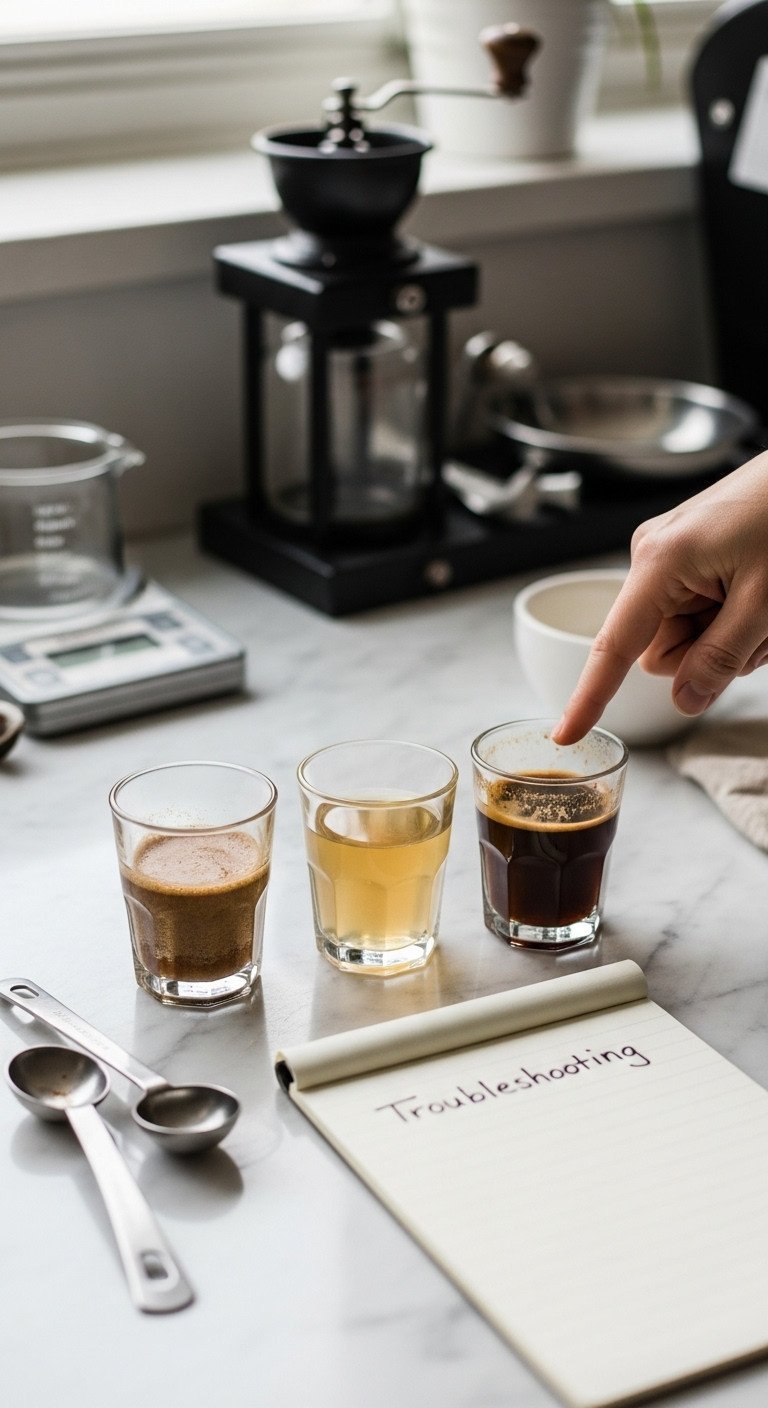
Fix your cold brew fails instantly with this guide!
Even with a perfect recipe, things can sometimes go wrong. Understanding how to diagnose and fix common problems is the final step to true mastery. Nearly every issue can be traced back to one of the core variables: grind, ratio, time, or filtration.
Diagnosis Checklist:
- Bitter Taste: Almost always caused by a grind that is too fine or a steep time that is too long (over 20-24 hours).
- Weak/Thin Flavor: The result of a brewing ratio that is too diluted (e.g., higher than 1:12) or a steep time that is too short (under 12 hours).
- Cloudy/Gritty Concentrate: A clear sign of poor filtration. This is often caused by using a blade grinder, which creates too many fines, or by skipping the fine filtration step.
Solutions:
- Stop Bitterness: For your next batch, set your burr grinder to an even coarser setting (Step 2) and shorten your steep time to the 16-18 hour window (Step 3).
- Fix Weakness: Ensure you are measuring by weight with a 1:8 ratio or stronger (Step 1). If the flavor is still thin, increase your steep time up to the 20-hour mark.
- Ensure Clarity: Never skip the second, fine filtration pass with a paper filter (Step 5). This is the only way to guarantee a sediment-free finish.
- Test Before Dilution: Always taste a tiny bit of the pure concentrate before diluting. If the concentrate itself is flawed (bitter or weak), dilution will only mask the problem, not fix it. Adjust your brewing variables for the next batch.
Lesson Learned: A common mistake is using pre-ground coffee from the store, which is almost always a “drip grind.” This is far too fine for cold brew and is the leading cause of bitter, gritty results for beginners.
9. Maximizing Storage Longevity and Preventing Spoilage
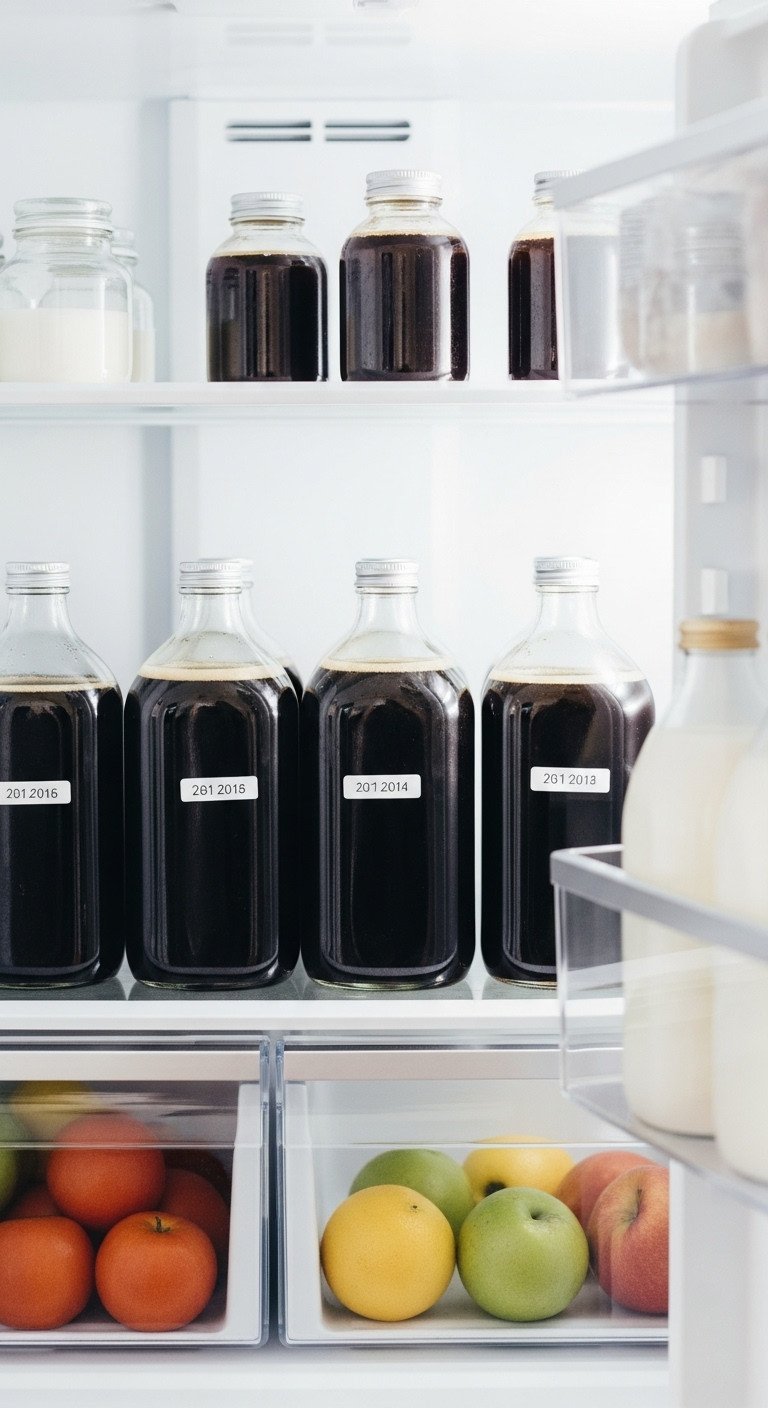
Keep your brew fresh for up to two weeks—pin these tips!
One of the greatest benefits of cold brew is the ability to make a large batch that lasts all week. Proper storage is key to preserving its fresh flavor and preventing spoilage. Your two main enemies are oxygen and bacteria.
Storage Needs:
- Airtight Glass Storage Bottles (preferably dark glass)
- Labels or Date Marker
- Dedicated Refrigerator Space
Steps for Maximum Longevity:
- Filter Immediately: As soon as your steeping time is complete, filter the concentrate. Leaving grounds to soak for days increases the risk of oxidation and off-flavors.
- Transfer to Airtight Glass: Move the finished concentrate into a sterilized, airtight glass container. Glass is non-porous and won’t absorb or leach flavors like plastic can.
- Refrigerate Promptly: Cold brew concentrate is not shelf-stable and must be stored in the refrigerator. The cold temperature is critical for slowing down oxidation and bacterial growth.
- Use Within 14 Days: While your concentrate is generally safe for up to two weeks, its optimal flavor peaks within the first 7 days. For longer storage, freeze concentrate in ice cube trays and transfer the cubes to a freezer bag.
Trust Signal: Always start with a clean, sterilized brewing vessel and storage container. Because of the long, low-temperature steep, taking precautions against contamination is crucial for producing a safe and delicious final product.
10. Immersion vs. Drip: Comparing Cold Brew Equipment

Deciding on a cold brew maker? Pin this comparison!
While you can make excellent cold brew in a simple mason jar, various types of equipment are designed to simplify the process, especially filtration. The two main categories are immersion brewers and cold drip systems.
Equipment Options:
- Immersion Brewer (e.g., dedicated Toddy, French Press)
- Cold Drip System (Kyoto Tower)
- Simple Steeping Vessel (Mason Jar, Pitcher)
How to Choose Your Method:
- Immersion (Best for 95% of Users): This is the method detailed throughout this guide, where coffee grounds are fully submerged in water. It’s simple, high-yield, and produces a rich concentrate. Dedicated systems like the Toddy make the filtration process cleaner and easier.
- Cold Drip (For Aficionados): Also known as Kyoto-style, this method involves slowly dripping cold water over a bed of coffee grounds for 5-8 hours. It produces an incredibly clean, delicate, and tea-like coffee but requires expensive, specialized equipment and constant monitoring.
- French Press (Convenient Filtration): If you already own a French press, it’s a great tool for small-batch immersion brewing. After 18 hours, you can slowly press the plunger to perform the first coarse filtration pass before pouring the liquid through a paper filter.
Expert Insight: While a dedicated brewer like a Toddy system offers great convenience, a high-quality burr grinder (Step 2) is a far more critical investment for improving your cold brew quality than any specific brewing vessel.
11. Advanced Applications: From Nitro to Frappes
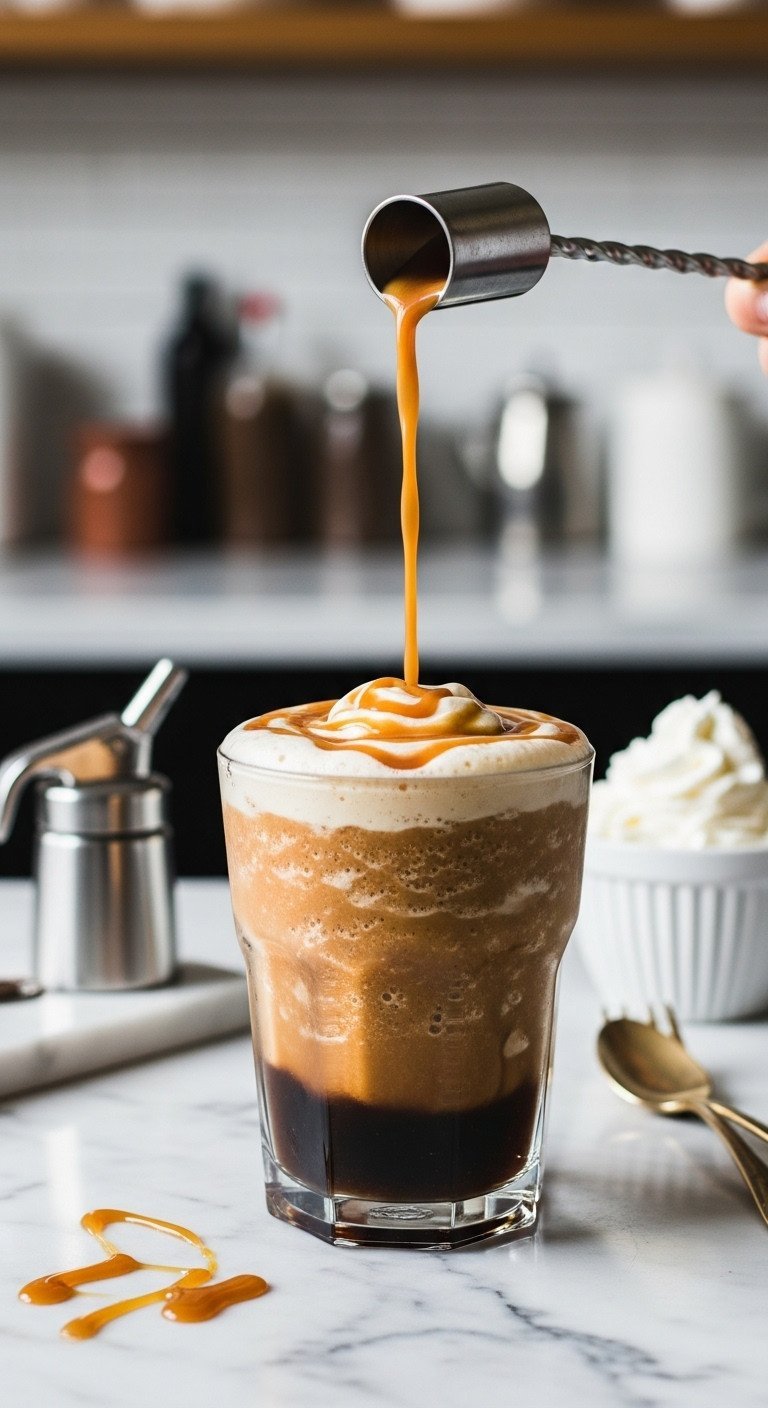
Take your concentrate to the next level—pin the recipes!
Once you’ve mastered your cold brew concentrate, a world of creative coffee drinks opens up. Its smooth, potent flavor makes it an incredibly versatile base for everything from creamy nitro brews to decadent cocktails.
Ingredients & Tools:
- Cold Brew Concentrate (1:8 ratio)
- Nitrogen Charger / Whipped Cream Dispenser (for Nitro)
- Blender (for Frappes)
- Mixers (milk, simple syrup, alcohol)
Usage Directions:
- Homemade Nitro: Fill a whipped cream dispenser with undiluted cold brew concentrate. Charge it with a nitrous oxide (N2O) cartridge, shake vigorously for 30 seconds, and dispense into a glass to enjoy a creamy, cascading nitro cold brew.
- Cold Brew Frappe: In a blender, combine 4oz concentrate, 4oz milk, 2 tablespoons of your preferred sweetener, and a large cup of ice. Blend until smooth and thick.
- Hot Coffee Base: To create a hot, low-acid coffee, simply mix 2oz of concentrate with 4-6oz of hot (not boiling) water. This is a great way to enjoy the smooth flavor profile in a warm beverage.
- Concentrate Cocktails: Use your cold brew concentrate as a direct replacement for espresso shots in cocktails like an espresso martini for a smoother, less bitter foundation.
Pro-Tip: For the best foam and cascading effect when making nitro cold brew at home, always use the concentrate straight from the fridge and undiluted inside the charger.
Cold Brew vs. Iced Coffee: Clarifying the Low-Acid Distinction
Although often used interchangeably, cold brew coffee and iced coffee are two fundamentally different beverages. Understanding this distinction is key to appreciating why cold brew offers such a unique, smooth flavor.
The primary difference is the brewing temperature. Iced coffee is simply regular hot-brewed coffee that has been cooled down and poured over ice, retaining its natural acidity and bitterness. The hot water used in its preparation performs a “hot bloom,” rapidly extracting all compounds, including the harsh chlorogenic acids.
Cold brew coffee, on the other hand, is brewed entirely without heat. This cold water extraction process is much gentler, resulting in a coffee concentrate that is significantly smoother and lower in acid. The final products may look similar in a glass, but their chemical makeup and taste profiles are worlds apart.
Key Takeaways: Your Quick Guide to Perfect Cold Brew in 2025
To ensure a flawless brewing process every time, remember these five most critical rules. This is your quick guide to mastering cold brew coffee.
- The Golden Ratio: Start with 1 part coffee to 8 parts cold water by weight (1:8) for a versatile and potent concentrate.
- Grind is King: Use a coarse, uniform grind (like coarse sea salt) from a burr grinder to prevent over-extraction and bitterness. Never use a fine drip-grind.
- Optimal Steep: Steep your coffee for 16 to 20 hours in the refrigerator or another cool, dark place for maximum flavor without bitterness.
- Double Filter: For a professional, clean finish, filter the brew through a fine mesh strainer first, then a second time through a paper filter to remove all sediment.
- Dilution is Mandatory: Always dilute your finished concentrate, typically 1:1 or 1:2 with water or milk, before drinking due to its high caffeine content.
People Also Ask About Cold Brew Ratio Secrets
Is my cold brew concentrate supposed to be bitter?
No, quality cold brew concentrate should be smooth, rich, and often chocolatey, not bitter. Bitterness is the most common sign of over-extraction. This is usually caused by using coffee grounds that are too fine or by steeping the brew for too long (over 24 hours). For your next batch, use a coarser grind and reduce the steep time.
How long can cold brew concentrate safely last in the refrigerator?
Properly stored cold brew concentrate will remain safe to drink for up to 14 days when kept in an airtight container in the refrigerator. However, for the best possible flavor, it’s recommended to consume it within the first 7 days. After a week, gradual oxidation can begin to dull the coffee’s more delicate flavor notes.
Can I use pre-ground coffee for making cold brew?
While you technically can, using pre-ground coffee for cold brew is strongly discouraged. Most pre-ground coffee is milled for drip machines, which is far too fine for a long immersion brew. This fine grind will almost always lead to a bitter, over-extracted concentrate that is cloudy and full of gritty sediment.
Is cold brew higher in caffeine than hot drip coffee?
Yes, the concentrate used to make cold brew is significantly higher in caffeine than an equivalent volume of hot drip coffee. A 4oz serving of concentrate can contain 150-250mg of caffeine. However, after you dilute the concentrate to make your final drink, the caffeine level is often comparable to a strong cup of hot coffee.
Final Thoughts
The secret to mastering cold brew coffee isn’t magic—it’s precision. By focusing on the scientific variables—the 1:8 ratio, the coarse grind, and the 18-hour window—you move beyond guesswork and achieve a repeatable, professional-grade low-acid brew every time. We’ve shown you the secrets to extraction and dilution that will keep your routine efficient and your final cup smooth for the entire November of 2025.
Now, which of the 11 secrets are you implementing in your next batch? Let us know in the comments below
Last update on 2025-11-19 / Affiliate links / Images from Amazon Product Advertising API

